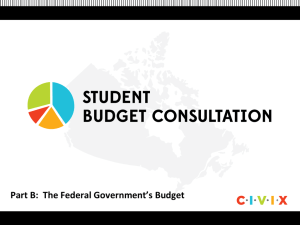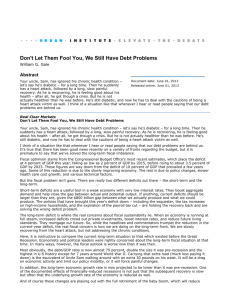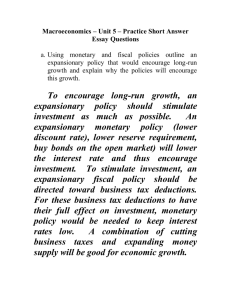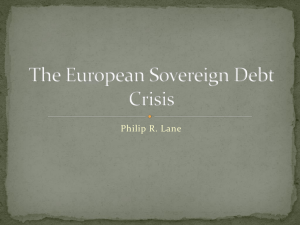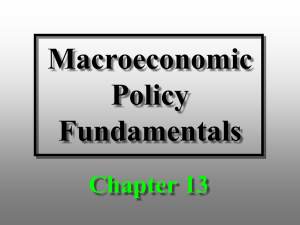CHAPTER 12 QUESTIONS
advertisement
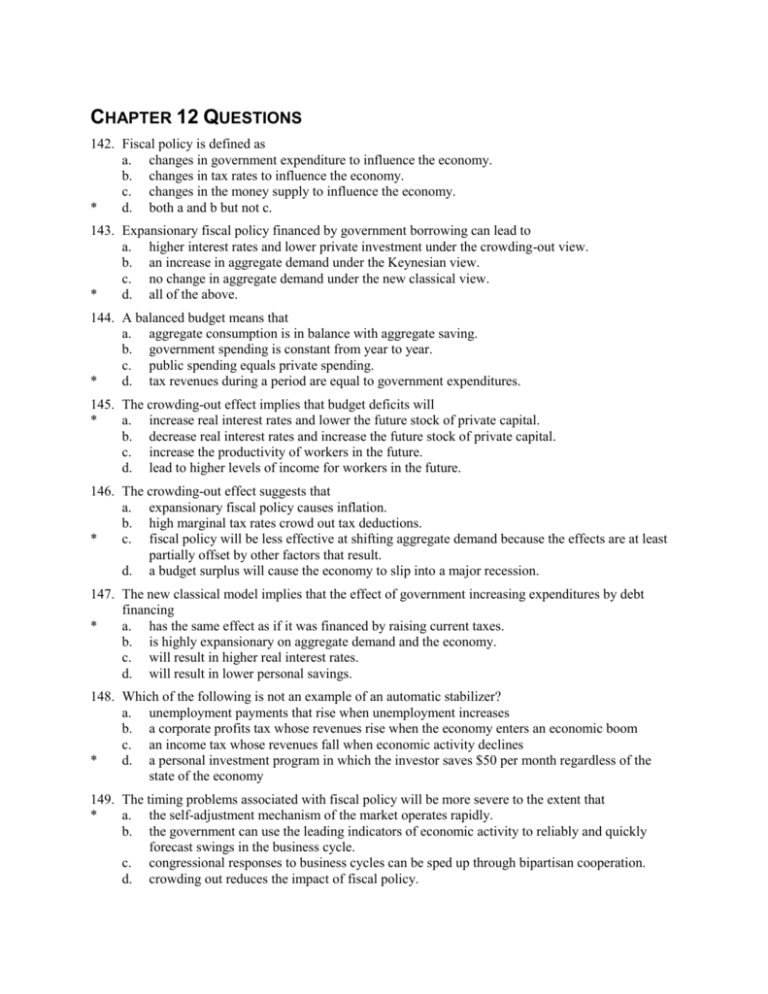
CHAPTER 12 QUESTIONS 142. Fiscal policy is defined as a. changes in government expenditure to influence the economy. b. changes in tax rates to influence the economy. c. changes in the money supply to influence the economy. * d. both a and b but not c. 143. Expansionary fiscal policy financed by government borrowing can lead to a. higher interest rates and lower private investment under the crowding-out view. b. an increase in aggregate demand under the Keynesian view. c. no change in aggregate demand under the new classical view. * d. all of the above. 144. A balanced budget means that a. aggregate consumption is in balance with aggregate saving. b. government spending is constant from year to year. c. public spending equals private spending. * d. tax revenues during a period are equal to government expenditures. 145. The crowding-out effect implies that budget deficits will * a. increase real interest rates and lower the future stock of private capital. b. decrease real interest rates and increase the future stock of private capital. c. increase the productivity of workers in the future. d. lead to higher levels of income for workers in the future. 146. The crowding-out effect suggests that a. expansionary fiscal policy causes inflation. b. high marginal tax rates crowd out tax deductions. * c. fiscal policy will be less effective at shifting aggregate demand because the effects are at least partially offset by other factors that result. d. a budget surplus will cause the economy to slip into a major recession. 147. The new classical model implies that the effect of government increasing expenditures by debt financing * a. has the same effect as if it was financed by raising current taxes. b. is highly expansionary on aggregate demand and the economy. c. will result in higher real interest rates. d. will result in lower personal savings. 148. Which of the following is not an example of an automatic stabilizer? a. unemployment payments that rise when unemployment increases b. a corporate profits tax whose revenues rise when the economy enters an economic boom c. an income tax whose revenues fall when economic activity declines * d. a personal investment program in which the investor saves $50 per month regardless of the state of the economy 149. The timing problems associated with fiscal policy will be more severe to the extent that * a. the self-adjustment mechanism of the market operates rapidly. b. the government can use the leading indicators of economic activity to reliably and quickly forecast swings in the business cycle. c. congressional responses to business cycles can be sped up through bipartisan cooperation. d. crowding out reduces the impact of fiscal policy. 150. When the federal government is running a budget surplus, * a. government revenues exceed government expenditures. b. government expenditures exceed government revenues. c. the economy must be in a recession. d. the government will have to borrow money. 151. Consider an economy for which the government budget is in balance when the economy operates at long-run capacity. If policy makers do not alter either tax rates or expenditure programs, during a recession, automatic stabilizers will tend to cause a. the budget to remain automatically in balance. * b. a budget deficit to occur. c. a budget surplus to occur. d. the recession to continue indefinitely. 152. An economy is in an inflationary boom, and unemployment is at a record low level. According to the Keynesian model, which of the following policies would be most appropriate? a. an increase in government expenditures b. an increase in the money supply * c. a tax increase d. a tax cut 153. If policy makers believe a recession is coming, the Keynesian view indicates that they should * a. increase government spending and/or decrease taxes. b. increase taxes while holding government spending constant. c. balance the budget. d. increase tax rates, reduce government spending, and shift toward a budget surplus. 154. If a budget surplus leads to a decrease in U.S. real interest rates, the lower rates will tend to cause a. the dollar to appreciate. * b. the dollar to depreciate. c. a decrease in private investment. d. a decrease in net exports. 155. The new classical model implies that a shift to a more expansionary fiscal policy will a. stimulate aggregate demand and employment. b. retard aggregate demand and employment. c. increase the real rate of interest. * d. exert little or no impact on the real interest rate, aggregate demand, and employment. 156. According to the new classical view, a $20 billion increase in government expenditures financed by a budget deficit will a. stimulate output by $20 billion. b. stimulate output more than $20 billion. c. stimulate output but by less than $20 billion. * d. leave output unchanged. 157. Automatic stabilizers are government programs that tend to a. increase the ups and downs in aggregate demand without legislative action. b. bring expenditures and revenues automatically into balance without legislative action. * c. move government spending and revenues in countercyclical directions without legislative action. d. increase tax collections automatically during a recession. 158. Other things constant, an increase in marginal tax rates will a. decrease the supply of labor and reduce its productive efficiency. b. decrease the supply of capital and decrease its productive efficiency. c. encourage individuals to buy goods that are tax deductible instead of those that are more desired but nondeductible. * d. do all of the above. 159. Which of the following statements is true? a. The empirical evidence indicates that countries with higher marginal tax rates have higher economic growth rates. b. Unlike other policies, supply-side tax cuts have their full impact on an economy instantaneously. * c. The supply-side effects of changes in marginal tax rates take place over lengthy time periods. d. In the 1960s and 1980s, when the marginal tax rates were reduced, the share of income taxes paid by high-income taxpayers fell. 160. Although the economy was entering the Great Depression, the Hoover administration followed a policy leading to a balanced budget. According to Keynesian theory, this balanced-budget fiscal policy was a. correct. b. incorrect; the government should have been running a surplus. * c. incorrect; the government should have been running a deficit. d. correct if expenditures were cut, incorrect if taxes were increased. 161. The modern synthesis view of fiscal policy stresses a. the fact that changes in marginal tax rates have no effect on the economy. b. that offsetting factors make fiscal policy much less effective than the Keynesian view suggested. c. that proper timing of fiscal policy is very difficult to achieve, rendering fiscal policy less useful as a stabilization tool. * d. that both b and c are true. 162. Which of the following is the best explanation of how expansionary fiscal policy can crowd out net exports? a. Expansionary fiscal policy leads to high budget deficits. Foreigners become concerned about the stability of the United States and stop buying American goods as a result. b. When the government spends more, some of its spending is on foreign goods. As imports rise, net exports fall. * c. The higher interest rates associated with expansionary fiscal policy attract foreign investors. To buy U.S. financial assets, foreigners bid up the real exchange rate, which in turn causes net exports to fall. d. The cut in taxes associated with expansionary fiscal policy stimulates aggregate supply. As aggregate supply rises, consumers have a greater incentive to purchase domestic goods, causing imports to fall and net exports to drop. 163. Which of the following groups would be least likely to support a balanced budget amendment to the U.S. Constitution? * a. Keynesians b. new classicals c. supply-siders d. believers in the crowding-out view 164. “Expansionary fiscal policy will tend to substantially increase current real output.” Which of the following models would tend to support such a statement? a. the Keynesian model and the new classical model, but not the crowding-out model b. the Keynesian model and the crowding-out model, but not the new classical model * c. the Keynesian model, but not the crowding-out and new classical models d. all three models 165. Unemployment compensation works as an automatic stabilizer because a. when it runs out during recessions, the unemployed are forced to find jobs, thus stimulating the economy to move back to long-run equilibrium. b. during recessions, unemployment compensation lowers disposable income, thus stabilizing consumption. c. changes in unemployment compensation laws change the natural rate of unemployment, thus helping the economy return rapidly to its long-run equilibrium following shocks. * d. the unemployment compensation program helps to stabilize income (and thus consumption) by paying out more during recessions and falling during booms. TOPIC 5 QUESTIONS 65. * Which of the following is a true statement about the federal deficit and the national debt? a. Both are “flow” concepts. b. The deficit is a “flow” concept, and the debt is a “stock” concept. c. The deficit is a “stock” concept, and the debt is a “flow” concept. d. Both are “stock” concepts. 66. * The external debt is the portion of the national debt a. owned by foreigners. b. owned by the public instead of the Fed. c. owned by any party other than the Treasury Department. d. attributable to off-budget federal programs. 67. Privately held government debt is a. the portion of the national debt held by government agencies. b. the portion of the national debt that imposes a net interest burden on the federal government. c. the portion of the national debt held by foreign citizens. d. equal to the federal government debt minus any state and local government surpluses. * 68. * Domestically financed deficit spending shifts the cost of government spending to future generations by a. causing a higher future tax liability with no offsetting gains. b. shifting the opportunity cost of the resources used by government onto future generations. c. reducing the capital stock, lowering productivity and wages. d. doing all of the above. 69. * 70. * According to the traditional view of deficit financing, an increase in debt-financed government expenditure a. causes interest rates to rise, private investment to fall, net exports to fall, and an inflow of foreign capital. b. causes interest rates to rise, private investment to fall, net exports to fall, and an outflow of domestic capital. c. causes interest rates to fall, private investment to rise, net exports to increase, and an inflow of foreign capital. d. causes interest rates to fall, private investment to fall, net exports to fall, and an outflow of domestic capital. Since 1970, the federal debt has expanded rapidly because a. revenues have gone down, while expenditures have gone up. b. expenditures have risen faster than revenues. c. expenditures have increased slightly, while revenues have remained about the same. d. revenues have fallen faster than expenditures. 71. * The difference between the federal budget deficit and the national debt is that a. the national debt is the cumulative effect of all prior surpluses and deficits. b. the budget deficit is the cumulative effect of all prior debts and surpluses. c. the debt includes all outstanding bonds, while the deficit excludes bonds held by government agencies. d. there is no difference. 72. Widespread acceptance of the Keynesian theory of fiscal policy a. caused most economists to reject the public choice view of budget deficits. b. relaxed the political pressure to balance the budget and, hence, paved the way for the continual budget deficits of recent decades. c. was based on the view that continual budget deficits would help stabilize the economy. d. increased the pressure for a constitutional amendment mandating that the federal government balance its budget. * The table below shows the revenues and expenditures for a new country during its first three years of existence. Use this data to answer the following questions. 73. * 74. * Year Government Revenues First Second Third $100 $150 $200 In the first year, this country a. ran a deficit of $210. b. had a surplus of $10. c. ran a deficit of $10. d. had a surplus of $210. In the second year, this country a. ran a surplus of $20. b. ran a surplus of $30. c. had a deficit of $20. d. had a deficit of $30. Government Expenditures $110 $120 $250 75. * 76. * 77. * 78. * 79. * 80. * 81. * Which of the following is correct regarding this government in the above table? a. In the third year, it had a $50 national debt and ran a $30 deficit. b. In the third year, it ran a $50 deficit, and its national debt after the third year was $60. c. In the third year, it ran a $50 surplus, and its national debt after the third year was $30. d. In the third year, it ran a $50 deficit, and its national debt after the third year was $30. Why are the bonds held by the Fed and government agencies excluded from the privately held debt figures? a. The U.S. Treasury does not have to pay off these bonds. b. These bonds were not issued by the Treasury. c. These bonds do not represent a net-interest obligation of the government. d. These bonds are not interest-bearing bonds. In 2003, the privately held federal debt was approximately what percent of GDP? a. 19 percent b. 29 percent c. 49 percent d. 100 percent The idea that a large public debt is “mortgaging the future of our children and grandchildren” is misleading because a. it is the Federal Reserve that will be responsible for making interest payments on the debt. b. future generations will have to bear the opportunity costs of the resources that are used today. c. future generations will not owe any interest obligations on the debt. d. future generations will inherit interest payments along with interest obligations. Deficit spending and a large national debt can have important effects on future generations because they a. allow generations to pass the opportunity costs of government spending onto future generations. b. can significantly impact spending on capital formation. c. pass costs onto future generations with no corresponding benefits. d. will cause the government to go bankrupt Currently, the Social Security trust fund is running a a. deficit, which reduces the apparent size of the budget deficit. b. surplus, which reduces the apparent size of the budget deficit. c. surplus, which increases the apparent size of the budget deficit. d. deficit, which increases the apparent size of the budget deficit. If the revenues and expenditures of the Social Security trust fund were not included when calculating the budget deficit, the recalculated deficit would a. be larger. b. be smaller. c. be unchanged. d. actually be a surplus. CHAPTER 13 QUESTIONS 167. If the Fed used “open market operations” to decrease the money supply, it a. increased the federal funds rate. b. issued more federal government debt. * c. sold U.S. government securities (bonds) to the general public. d. increased the required reserve ratio. 168. Suppose the Fed buys $10 million of U.S. securities from the public. Assume a reserve requirement of 5 percent and that all banks hold no excess reserves. The total impact of this action on the money supply will be * a. an increase of $200 million. b. a decrease of $200 million. c. a decrease of $10 million. d. an increase of $10 million. 169. In the United States, the control of the money supply is the responsibility of the * a. Federal Reserve System (the Fed). b. president. c. U.S. Treasury. d. U.S. Congress. 170. Further difficulties in measuring the money supply can be expected in the future as a. the penny is likely to be discontinued from circulation. b. the U.S. Congress continues the process of decreasing the independence of the Fed. c. the volume of transactions conducted with credit cards continues to escalate. * d. debit cards and electronic money come into widespread use. 171. Suppose a bank receives a new deposit of $500. The bank extends a new loan of $400 because it is required to hold the other $100 on reserve. What is the legal required reserve ratio? a. 10 percent b. 15 percent * c. 20 percent d. 25 percent 172. Fiat money is defined as a. the money of U.S. citizens deposited at banks and other financial institutions outside the United States. b. money spent on Italian sports cars. * c. money that has little intrinsic value; it is neither backed by nor convertible to a commodity of value. d. vault cash plus deposits at the Fed. 173. The most frequently used tool of the Fed to control the money supply in recent years has been a. changes in the premiums charged for FDIC deposit insurance. * b. open market operations. c. changes in the discount rate. d. changes in reserve requirements. 174. The federal funds rate is the interest rate * a. banks pay when they borrow money from each other. b. the federal government pays on the national debt. c. the Fed charges banks when banks need to borrow from the Fed. d. the federal government charges foreign banks. 175. The three basic functions of money are a. fiat, seignior age, and debt. * b. a medium of exchange, a store of value, and a unit of account. c. a standard of pay, a coincidence of wants, and a measure of the value of time. d. demand deposits, other checkable deposits, and time deposits. 176. If the Federal Reserve wanted to expand the supply of money to head off a recession, it could * a. decrease the reserve requirements. b. lower taxes. c. sell U.S. securities in the open market. d. increase the discount rate. 177. The larger the reserve requirement, the a. larger the potential deposit multiplier. * b. smaller the potential deposit multiplier. c. more profitable the banks will be. d. larger the proportion of an additional deposit that is available to the bank for the extension of additional loans. 178. The total expansion in the money supply can be less than is predicted by the deposit expansion multiplier if a. banks choose to hold some excess reserves rather than lending all excess reserves. b. some individuals prefer to hold cash instead of depositing their money in banks. c. instead of a monopoly banking system, there are many banks. * d. both a and b are correct. 179. If the Fed wanted to use all three of its tools to decrease the money supply, it would a. decrease the discount rate, decrease reserve requirements, and buy bonds. b. decrease the discount rate, decrease reserve requirements, and sell bonds. c. increase the discount rate, increase reserve requirements, and buy bonds. * d. increase the discount rate, increase reserve requirements, and sell bonds. 180. When economists say that money serves as a unit of account, they mean that money a. allows people to avoid barter (trading goods for other goods) by using money. b. is always issued in fixed denominations (for example $1, $5, $10, $20 bills). * c. allows people to value all goods and services in terms of one commodity (money), rather than in terms of several commodities. d. makes it easier for people to maintain value across time by letting them save it in the form of money, rather than in the form of physical goods that might depreciate over time. 181. The value (purchasing power) of each unit of money a. does not depend on the amount of money in circulation. b. tends to increase as the money supply expands. c. increases as prices rise. * d. is inversely related to prices (in other words, money’s value falls as prices rise and vice versa). 182. Which of the following is not a component of the M1 money supply? a. demand deposits b. large-denomination (more than $100) bills c. interest-earning checking deposits * d. outstanding balances on credit cards 183. Which of the following compose the M2 money supply? a. currency only b. currency, demand deposits, other checkable deposits, and traveler’s checks c. M1 plus large denomination time deposits * d. M1 plus savings deposits, small-denomination time deposits, and money market mutual funds (retail) 184. The difference between the total reserves that a bank holds and the amount that is required by law is called * a. excess reserves. b. non-borrowed reserves. c. borrowed reserves. d. actual reserves. 185. A reserve requirement of 20 percent implies a potential money deposit multiplier of a. 1. * b. 5. c. 20. d. 80. 186. Suppose the Fed sells $100 million of U.S. government securities (bonds) to the public. How will this affect the money supply and the national debt? a. The money supply will increase; the national debt will decrease. b. The money supply will decrease; the national debt will increase. c. The money supply will increase; the national debt will be unaffected. * d. The money supply will decrease; the national debt will be unaffected. 187. Suppose the U.S. Treasury issues and sells $100 million of U.S. government securities (bonds) to the public. How will this affect the money supply and the national debt? a. The money supply will increase; the national debt will decrease. b. The money supply will decrease; the national debt will increase. * c. The money supply will be unaffected; the national debt will increase. d. The money supply will be unaffected; the national debt will decrease. 188. Which of the following is not part of the M1 money supply? a. paper bills (currency) b. traveler’s checks * c. savings deposits d. coins 189. Saying that the Fed is an “independent” central bank means a. members of the Fed are not allowed to register with a political party. * b. the Fed is insulated from the political pressures of voters and politicians seeking reelection. c. the Fed is a private bank that has no links to the government. d. the Fed has control over the money supply of foreign nations. CHAPTER 14 QUESTIONS 149. A decrease in the nominal (or money) interest rate would a. encourage people to hold smaller money balances. * b. encourage people to hold larger money balances. c. force the Fed to increase the money supply. d. cause the real interest rate to rise. 150. According to monetarists, which of the following would most likely eliminate inflation? a. a steady increase in federal expenditures at an annual rate of approximately 3 percent b. indexing of wages, taxes, and pensions to the rate of inflation * c. a steady expansion in the money supply at a rate no greater than the long-run growth of real output d. a steady 3 percent increase in the size of the budget deficit 151. Given the strict quantity theory of money, if the quantity of money doubled, prices would a. fall by half. * b. double. c. remain constant. d. increase somewhat but less than double. 152. The velocity of money is 6, the amount of money in circulation is $200 million, prices are 120, and real GDP is $10 million. According to the strict quantity theory of money, if the money supply increased to $400 million, a. velocity of money would fall to 3. * b. prices would increase to 240. c. real GDP would increase to $20 million. d. it is unclear what would happen to GDP, prices, and the money velocity. 153. If the amount of money in circulation is $200 million and nominal GDP is $400 million, the velocity of money is a. 0.5. * b. 2. c. 200. d. 400. 154. If the growth rate of real GDP is 3 percent, velocity is constant, and the money supply grows at 9 percent, the rate of inflation will be approximately a. 3 percent. * b. 6 percent. c. 9 percent. d. 12 percent. 155. When the Fed unexpectedly increases the money supply, it will cause an increase in aggregate demand because * a. real interest rates will fall, stimulating business investment and consumer purchases. b. the dollar will appreciate on the foreign exchange market, leading to a decrease in net exports. c. lower interest rates will tend to decrease asset prices (such as the prices of homes), which decreases wealth and, thereby, decreases current consumption. d. all of the above are true. 156. The most likely short-run impact of an unanticipated decrease in the money supply is a(n) a. decrease in the real interest rate, which in turn reduces investment and real GDP. * b. increase in the real interest rate, which in turn reduces investment and real GDP. c. increase in real output, which causes the interest rate to rise and, in turn, reduces investment and real GDP. d. decrease in real output, which causes the real interest rate to rise. 157. An unanticipated increase in the money supply will initially exert its primary impact on * a. output and employment rather than on prices. b. prices; output and employment will be largely unaffected. c. interest rates; rising interest rates will stimulate additional saving. d. prices if the economy operates at an output level below its long-run supply constraint. 158. If decision makers fully anticipate the effects of a shift to a more expansionary monetary policy, the policy will a. decrease the real rate of interest. b. increase real GDP in the short run. * c. increase prices (or the inflation rate) and leave real output unchanged. d. do all of the above. 159. Which of the following is true? a. An unanticipated shift to a more expansionary monetary policy will temporarily stimulate output and employment. b. Persistent growth of the money supply at a rapid rate will cause inflation. * c. Both a and b are true. d. None of the above are true. 160. In the short run, an unanticipated increase in the money supply will a. increase interest rates and shift the aggregate demand curve to the left. b. increase interest rates and shift the aggregate demand curve to the right. c. lower interest rates and shift the aggregate demand curve to the left. * d. lower interest rates and shift the aggregate demand curve to the right. 161. Suppose the economy is experiencing full employment. An unanticipated increase in the money supply will * a. raise real GDP and the price level in the short run, but in the long run will cause no change in real GDP and only a higher price level. b. lower real GDP and the price level in the short run, but in the long run will cause no change in real GDP and only a lower price level. c. cause no change in real GDP in either the short run or long run but will increase the price level. d. cause the price level to rise in the short run but will increase real GDP in the long run. 162. In the equation of exchange, V stands for * a. velocity, or the annual rate at which money changes hands in the purchase of final products. b. the investment component of aggregate demand. c. the amount of money in circulation. d. a constant equal to 3.1416, discovered by classical economists. 163. The demand curve for money a. would shift if the interest rate changed. b. shifts with an increase in the reserve requirement. * c. shows the relationship between the quantity of money demanded and the interest rate. d. is a relationship between the quantity of investment demanded and the interest rate. 164. If velocity was constant, real GDP was growing at 5 percent, and the money supply was allowed to grow at 3 percent, inflation would be a. 8 percent. b. 2 percent. * c. –2 percent. d. 4 percent. 165. Classical economists, who adhered to the quantity theory of money, believed that an increase in the money supply would cause a. a proportional change in velocity. b. a proportional change in real GDP. * c. a proportional change in prices. d. no effect on velocity, prices, or real GDP. 166. “Inept government monetary policy is the major source of economic instability. Monetary expansion has been the source of every major inflation. Every major recession was perpetuated by monetary contraction. We would have less instability if we simply required the monetary authorities to stabilize the growth rate of the money supply.” This quote is indicative of the views of a. the classical economists. b. both Keynesians and monetarists. * c. the monetarists. d. the Keynesians. 167. Under conditions of very high inflation but full employment, a new chairperson is appointed to the Federal Reserve. To bring the rate of inflation down, he decides to cut the growth rate of the money supply substantially. a. If the policy is announced and is fully anticipated, it will bring the inflation down without affecting real GDP. b. If the policy is unanticipated, it will cause the economy to go through a short-run recession. c. He has followed the wrong policy; the money supply growth should have been increased to lower the inflation rate. * d. Both a and b are correct. Use the figure below to answer the following questions. Figure 8 168. In Figure 8, AD1 and SRAS1 indicate the initial conditions in an economy, with the current level of output, Y2, being the full-employment level, and the current price level is P1. If the Fed unexpectedly increases the money supply, the short-run impact of this policy will be a movement to a. P1 and Y2. b. P2 and Y1. * c. P2 and Y3. d. P3 and Y2. 169. Continuing with the change in question 168, in the long run in Figure 8, the impact of the unanticipated expansionary policy will be a movement to a. P1 and Y2. b. P2 and Y1. c. P2 and Y3. * d. P3 and Y2. 170. Return to the original initial conditions at AD1 and SRAS1, shown by output of Y2 and a price level of P1 in Figure 8. Suppose the increase in the money supply had instead been fully anticipated. The shortrun impact of this policy will be a movement to a. P1 and Y2. b. P2 and Y1. c. P2 and Y3. * d. P3 and Y2. 171. Continuing with the change in question 170, in the long run in Figure 8, the impact of the anticipated expansionary policy will be a movement to a. P1 and Y2. b. P2 and Y1. c. P2 and Y3. * d. P3 and Y2. 172. Based upon your answers to the previous questions, which of the following is a true statement? a. Expansionary monetary policy has the same effect in the long run regardless of whether it is originally anticipated or unanticipated. b. Expansionary monetary policy increases real output only when it is unanticipated, and the increase is only in the short run. c. The primary long-run impact of expansionary monetary policy is a higher price level (or inflation). * d. All of the above are true.

